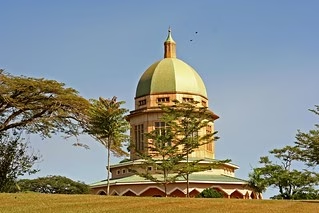The Bahá’í Temple: A Sanctuary of Peace, Unity, and Reflection in Uganda
Nestled atop Kampala Hill, the Bahá’í Temple is one of the most significant and beautiful landmarks in Uganda, serving as a place of worship, reflection, and learning.
This temple is part of a global network of Bahá’í Houses of Worship, with only eight such temples worldwide, making it a rare and important site for both Bahá’í followers and visitors.
It stands not only as a spiritual center for the Bahá’í community but also as a symbol of unity, welcoming people from all walks of life, regardless of their religious background.
Here’s a closer look at the Bahá’í Temple in Kampala, its interior, what activities visitors can engage in, and the temple’s significance in Uganda.
A Brief Overview of the Bahá’í Faith.
The Bahá’í Faith is a world religion founded in the 19th century by Bahá’u’lláh, which teaches the oneness of God, the unity of humanity, and the equality of all people.
Bahá’ís believe that all the major world religions are part of a unified divine plan, and their essential teachings are rooted in principles of peace, justice, and spiritual growth.
The Bahá’í Temple, with its emphasis on inclusivity, is a place where visitors can experience the core principles of this faith through prayer, reflection, and a deep commitment to the unity of humanity.
What’s Inside the Bahá’í Temple?
The Prayer Hall
The heart of the Bahá’í Temple is the prayer hall, an expansive and peaceful space where visitors and worshippers can connect with their spirituality.
The design is simple, without religious icons or images, in alignment with Bahá’í teachings that focus on the oneness of God and the unity of all religions.
The central dome of the temple is the focal point, symbolizing divine unity, and it is surrounded by large glass windows that allow natural light to flood the interior, creating an atmosphere of openness and transparency.
Sacred Texts and Literature
Inside the temple, visitors will find copies of Bahá’í scriptures, such as the Kitáb-i-Aqdas, the most sacred text of the Bahá’í Faith, along with other works by Bahá’u’lláh and writings from Bahá’í leaders.
These texts emphasize themes of unity, justice, and spiritual development. Visitors are encouraged to read these texts for personal reflection or to learn more about the Bahá’í teachings.
Activities You Can Do Inside the Bahá’í Temple
Prayer and Meditation
The prayer hall is an ideal space for personal prayer or meditation. Visitors can engage in silent prayer, reflecting on the unity of humanity and the teachings of the Bahá’í Faith.
The Bahá’í Faith encourages a deep, personal connection with God, and the temple’s calm atmosphere provides the perfect setting for such practices.
Visitors are free to choose from a variety of Bahá’í prayers and supplications or engage in silent reflection, fostering a sense of peace and spiritual renewal.
Reading and Learning
Visitors interested in learning more about the Bahá’í Faith can explore the temple’s collection of literature.
The books and writings available inside the temple offer insights into the principles of unity, peace, and justice that lie at the heart of the Bahá’í teachings.
Reading these texts is a great way to learn more about the faith and understand its emphasis on the oneness of God and the unity of humankind.
Reflection and Contemplation
The temple is a quiet sanctuary, designed to promote deep reflection and contemplation.
Visitors are encouraged to sit and think about the Bahá’í Faith‘s teachings on unity, love, and the interconnectedness of all people.
The architecture, with its open space and natural light, fosters a reflective environment, making it the perfect place to meditate on the commonality of all religions and the potential for peace in the world.
Participating in Group Worship and Events
The Bahá’í community occasionally holds group worship sessions in the temple, where individuals can join in collective prayers and celebrate significant days in the Bahá’í calendar, such as the birthdays of Bahá’u’lláh and Nawruz (the Bahá’í New Year).
These events may include music, songs, and reflections on the Bahá’í teachings. Visitors are encouraged to participate in these community events to experience the spirit of unity and shared faith.
Spiritual Talks and Lecture
The Bahá’í Temple also hosts lectures and discussions on Bahá’í teachings, focusing on the principles of peace, unity, and social justice.
These talks are often open to the public, providing visitors the opportunity to learn more about the faith and its global vision for a better world.
Visitors can engage in conversations and ask questions, deepening their understanding of the Bahá’í Faith and its commitment to social development and spiritual well-being.
The Surrounding Grounds and Gardens
Beyond the temple’s interior, the surrounding grounds offer a peaceful escape with well-maintained gardens.
The lush gardens and flower beds provide a serene setting where visitors can enjoy a quiet walk, reflect, or meditate on the messages of unity and peace that the Bahá’í Temple embodies.
The gardens also serve as a space for community gatherings, where the Bahá’í community occasionally organizes events related to social service, education, and peacebuilding.
How to Get to the Bahá’í Temple
The Bahá’í Temple is located on Kampala Hill, easily accessible from the center of Kampala, Uganda’s capital. The temple offers spectacular views of the city, and its elevated location makes it visible from various parts of Kampala.
By Car
The temple is a short drive from Kampala’s central business district. It’s situated in the Rubaga Division and can be reached by private car or taxi.
By Public Transport
Visitors can take a boda-boda (motorcycle taxi) or matatu (shared taxi) from various points in Kampala to the temple. It’s an easy and affordable journey from the city center.


